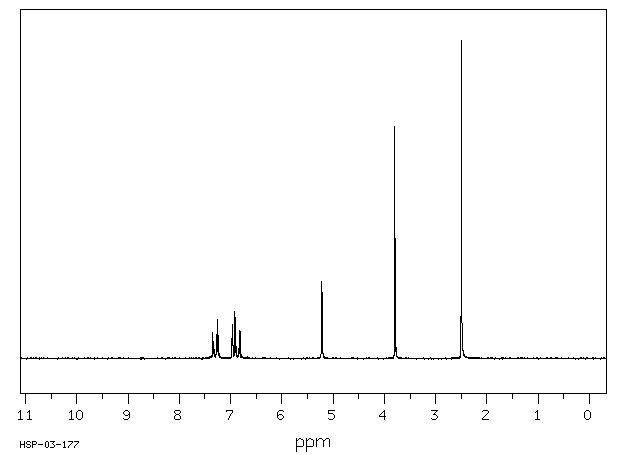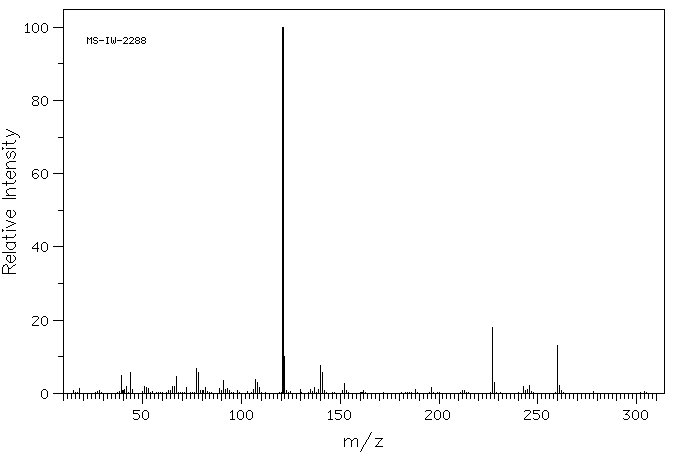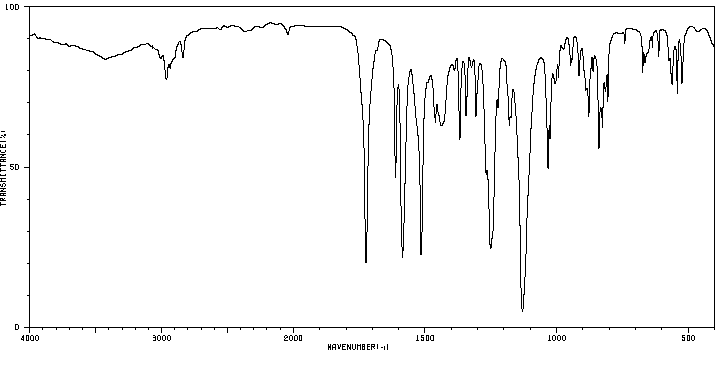对甲氧基苯基 S-(4,6-二甲基嘧啶-2-基)硫代碳酸酯 | 41840-29-3
中文名称
对甲氧基苯基 S-(4,6-二甲基嘧啶-2-基)硫代碳酸酯
中文别名
对甲氧基苯基S-(4,6-二甲基嘧啶-2-基)硫代碳酸酯;S-对甲氧基苄氧基羰基-4,6-二甲基-2-巯基嘧啶;S-(4,6-二甲基嘧啶-2-基)硫代碳酸宜乙基对甲氧基苄酯
英文名称
p-methoxybenzyl-S-(4,6-dimethylpyrimidin-2-yl)-thiocarbonate
英文别名
thiocarbonic acid (4,6-dimethyl-pyrimidin-2-yl)ester (4-methoxybenzyl) ester;S-(4,6-dimethyl-2-pyrimidinyl) O-(p-methoxybenzyl) thiocarbonate;S-p-methoxybenzyloxycarbonyl-4,6-dimethyl-2-mercaptopyrimidine;4-methoxybenzyl S-(4,6-dimethylpyrimidin-2-yl)thiolcarbonate;p-methoxybenzyl S-(4,6-dimethylpyrimidin-2-yl) thiocarbonate;thiocarbonic acid S-(4,6-dimethyl-pyrimidin-2-yl) ester O-(4-methoxy-benzyl) ester;S-(4,6-Dimethylpyrimidin-2-yl) O-(p-methoxybenzyl) thiocarbonate;(4-methoxyphenyl)methyl (4,6-dimethylpyrimidin-2-yl)sulfanylformate
CAS
41840-29-3
化学式
C15H16N2O3S
mdl
MFCD00006081
分子量
304.37
InChiKey
DDIJXDDZBQMPDQ-UHFFFAOYSA-N
BEILSTEIN
——
EINECS
——
-
物化性质
-
计算性质
-
ADMET
-
安全信息
-
SDS
-
制备方法与用途
-
上下游信息
-
文献信息
-
表征谱图
-
同类化合物
-
相关功能分类
-
相关结构分类
物化性质
-
沸点:488.9±47.0 °C(Predicted)
-
密度:1.26±0.1 g/cm3(Predicted)
-
稳定性/保质期:
常规情况下不会分解,没有危险反应。
计算性质
-
辛醇/水分配系数(LogP):3.5
-
重原子数:21
-
可旋转键数:6
-
环数:2.0
-
sp3杂化的碳原子比例:0.266
-
拓扑面积:86.6
-
氢给体数:0
-
氢受体数:6
安全信息
-
海关编码:2933599090
-
WGK Germany:3
-
储存条件:密封,在2至-8°C下保存
SDS
SECTION 1: Identification of the substance/mixture and of the company/undertaking
Product identifiers
Product name : p-Methoxybenzyl S-(4,6-dimethylpyrimidin-2-yl)
thiocarbonate
REACH No. : A registration number is not available for this substance as the substance
or its uses are exempted from registration, the annual tonnage does not
require a registration or the registration is envisaged for a later
registration deadline.
CAS-No. : 41840-29-3
Relevant identified uses of the substance or mixture and uses advised against
Identified uses : Laboratory chemicals, Manufacture of substances
SECTION 2: Hazards identification
Classification of the substance or mixture
Not a hazardous substance or mixture according to Regulation (EC) No. 1272/2008.
This substance is not classified as dangerous according to Directive 67/548/EEC.
Label elements
The product does not need to be labelled in accordance with EC directives or respective national laws.
Other hazards - none
SECTION 3: Composition/information on ingredients
Substances
Formula : C15H16N2O3S
Molecular Weight : 304,36 g/mol
CAS-No. : 41840-29-3
EC-No. : 255-563-7
No components need to be disclosed according to the applicable regulations.
SECTION 4: First aid measures
Description of first aid measures
If inhaled
If breathed in, move person into fresh air. If not breathing, give artificial respiration.
In case of skin contact
Wash off with soap and plenty of water.
In case of eye contact
Flush eyes with water as a precaution.
If swallowed
Never give anything by mouth to an unconscious person. Rinse mouth with water.
Most important symptoms and effects, both acute and delayed
The most important known symptoms and effects are described in the labelling (see section 2.2) and/or in
section 11
Indication of any immediate medical attention and special treatment needed
no data available
SECTION 5: Firefighting measures
Extinguishing media
Suitable extinguishing media
Use water spray, alcohol-resistant foam, dry chemical or carbon dioxide.
Special hazards arising from the substance or mixture
Carbon oxides, nitrogen oxides (NOx), Sulphur oxides
Advice for firefighters
Wear self contained breathing apparatus for fire fighting if necessary.
Further information
no data available
SECTION 6: Accidental release measures
Personal precautions, protective equipment and emergency procedures
Avoid dust formation. Avoid breathing vapours, mist or gas.
For personal protection see section 8.
Environmental precautions
Do not let product enter drains.
Methods and materials for containment and cleaning up
Sweep up and shovel. Keep in suitable, closed containers for disposal.
Reference to other sections
For disposal see section 13.
SECTION 7: Handling and storage
Precautions for safe handling
Provide appropriate exhaust ventilation at places where dust is formed.
For precautions see section 2.2.
Conditions for safe storage, including any incompatibilities
Store in cool place. Keep container tightly closed in a dry and well-ventilated place.
Recommended storage temperature: 2 - 8 °C
Specific end use(s)
A part from the uses mentioned in section 1.2 no other specific uses are stipulated
SECTION 8: Exposure controls/personal protection
Control parameters
Components with workplace control parameters
Exposure controls
Appropriate engineering controls
General industrial hygiene practice.
Personal protective equipment
Eye/face protection
Use equipment for eye protection tested and approved under appropriate government standards
such as NIOSH (US) or EN 166(EU).
Skin protection
Handle with gloves. Gloves must be inspected prior to use. Use proper glove removal technique
(without touching glove's outer surface) to avoid skin contact with this product. Dispose of
contaminated gloves after use in accordance with applicable laws and good laboratory practices.
Wash and dry hands.
The selected protective gloves have to satisfy the specifications of EU Directive 89/686/EEC and
the standard EN 374 derived from it.
Body Protection
Choose body protection in relation to its type, to the concentration and amount of dangerous
substances, and to the specific work-place., The type of protective equipment must be selected
according to the concentration and amount of the dangerous substance at the specific workplace.
Respiratory protection
Respiratory protection is not required. Where protection from nuisance levels of dusts are desired,
use type N95 (US) or type P1 (EN 143) dust masks. Use respirators and components tested and
approved under appropriate government standards such as NIOSH (US) or CEN (EU).
Control of environmental exposure
Do not let product enter drains.
SECTION 9: Physical and chemical properties
Information on basic physical and chemical properties
a) Appearance Form: powder
Colour: light yellow
b) Odour no data available
c) Odour Threshold no data available
d) pH no data available
e) Melting point/freezing Melting point/range: 59 - 62 °C
point
f) Initial boiling point and no data available
boiling range
g) Flash point no data available
h) Evapouration rate no data available
i) Flammability (solid, gas) no data available
j) Upper/lower no data available
flammability or
explosive limits
k) Vapour pressure no data available
l) Vapour density no data available
m) Relative density no data available
n) Water solubility no data available
o) Partition coefficient: n- no data available
octanol/water
p) Auto-ignition no data available
temperature
q) Decomposition no data available
temperature
r) Viscosity no data available
s) Explosive properties no data available
t) Oxidizing properties no data available
Other safety information
no data available
SECTION 10: Stability and reactivity
Reactivity
no data available
Chemical stability
Stable under recommended storage conditions.
Possibility of hazardous reactions
no data available
Conditions to avoid
no data available
Incompatible materials
Strong oxidizing agents
Hazardous decomposition products
Other decomposition products - no data available
In the event of fire: see section 5
SECTION 11: Toxicological information
Information on toxicological effects
Acute toxicity
no data available
Skin corrosion/irritation
no data available
Serious eye damage/eye irritation
no data available
Respiratory or skin sensitisation
no data available
Germ cell mutagenicity
no data available
Carcinogenicity
IARC: No component of this product present at levels greater than or equal to 0.1% is identified as
probable, possible or confirmed human carcinogen by IARC.
Reproductive toxicity
no data available
Specific target organ toxicity - single exposure
no data available
Specific target organ toxicity - repeated exposure
no data available
Aspiration hazard
no data available
Additional Information
RTECS: Not available
To the best of our knowledge, the chemical, physical, and toxicological properties have not been
thoroughly investigated.
SECTION 12: Ecological information
Toxicity
no data available
Persistence and degradability
no data available
Bioaccumulative potential
no data available
Mobility in soil
no data available
Results of PBT and vPvB assessment
PBT/vPvB assessment not available as chemical safety assessment not required/not conducted
Other adverse effects
no data available
SECTION 13: Disposal considerations
Waste treatment methods
Product
Offer surplus and non-recyclable solutions to a licensed disposal company.
Contaminated packaging
Dispose of as unused product.
SECTION 14: Transport information
UN number
ADR/RID: - IMDG: - IATA: -
UN proper shipping name
ADR/RID: Not dangerous goods
IMDG: Not dangerous goods
IATA: Not dangerous goods
Transport hazard class(es)
ADR/RID: - IMDG: - IATA: -
Packaging group
ADR/RID: - IMDG: - IATA: -
Environmental hazards
ADR/RID: no IMDG Marine pollutant: no IATA: no
Special precautions for user
no data available
SECTION 15: Regulatory information
This safety datasheet complies with the requirements of Regulation (EC) No. 1907/2006.
Safety, health and environmental regulations/legislation specific for the substance or mixture
no data available
Chemical Safety Assessment
For this product a chemical safety assessment was not carried out
SECTION 16: Other information
Further information
Copyright 2013 Co. LLC. License granted to make unlimited paper copies for internal use
only.
The above information is believed to be correct but does not purport to be all inclusive and shall be
used only as a guide. The information in this document is based on the present state of our knowledge
and is applicable to the product with regard to appropriate safety precautions. It does not represent any
guarantee of the properties of the product. Corporation and its Affiliates shall not be held
liable for any damage resulting from handling or from contact with the above product. See
and/or the reverse side of invoice or packing slip for additional terms and conditions of sale.
反应信息
-
作为反应物:参考文献:名称:Nitrogenous heterocyclic compounds and hyperlipemia remedy containing the same摘要:化合物的化学式(I)及其药学上可接受的盐和溶剂的披露。这些化合物可以抑制肝脏中三酸甘油酯的生物合成,并可以抑制肝脏中含载脂蛋白B的脂蛋白的分泌。因此,它们对于预防或治疗高脂血症(特别是高超低密度脂蛋白血症)和由高脂血症引起的心肌梗死或胰腺炎等动脉粥样硬化疾病是有用的。其中A代表基团—CR1R2—(CH2)i—,其中R1和R2分别代表氢原子或烷基,—CH═CH—,—O—CH2—或—S(O)j—CH2—;B代表氢或卤原子;X代表—CR3R4R5,—NR6R7,—(CH2—CH═C(CH3)—CH2)p—CH2CH═C(CH3)2,烷基,环烷基,苯基,肉桂基或杂环芳香环;Y代表—(CH2)q—,—CH═CH—,—NR8—,氧原子或键;Z代表酰基或键;K代表烷基或键;L代表—CH═CH—或键;M代表氢原子,烷基,环烷基,苯基,杂环环,联苯基或二苯基甲基。公开号:US06417362B1
文献信息
-
Amidine derivatives and cardiotonic compositions申请人:Torii & Co. Ltd.公开号:US04598077A1公开(公告)日:1986-07-01Amidine derivatives of the formula ##STR1## wherein R.sub.1 and R.sub.2, which may be the same or different, represent each a hydrogen atom or a lower alkyl group, or R.sub.1 and R.sub.2 together with an intermediary carbon atom and/or hetero atom may form a ring; X represents ##STR2## (wherein R.sub.8 represents a hydrogen atom, a lower alkyl group, or --CH.sub.2 COOR.sub.9, where R.sub.9 represents a hydrogen atom or a lower alkyl group; Z represents a single bond, --CH.sub.2 --, --CH.sub.2 CH.sub.2 --, or --CH.dbd.CH--); R.sub.3 represents a hydrogen or chlorine atom, methoxy group, nitro group, or amino group; Y represents --CH.sub.2 CH.sub.2 --, --CH.dbd.CH--, --CH.sub.2 O--, or --OCH.sub.2 --; R.sub.4 represents a hydrogen atom, methoxy group, benzoyl group, nitro group, or amino group; and R.sub.5, R.sub.6 and R.sub.7, which may be the same or different, represent each a hydrogen atom, lower alkyl group, cycloalkyl group, aralkyl group, substituted alkyl group, substituted aralkyl group, or amino group, or R.sub.5 and R.sub.7 may form a ring, or salts thereof have an excellent cardiotonic activity and can be used as cardiotonics.式##STR1##中的胺基衍生物,其中R.sub.1和R.sub.2,可以相同也可以不同,分别代表氢原子或低碳基团,或者R.sub.1和R.sub.2与中间的碳原子和/或杂原子一起可以形成环;X代表##STR2##(其中R.sub.8代表氢原子、低碳基团,或--CH.sub.2 COOR.sub.9,其中R.sub.9代表氢原子或低碳基团;Z代表单键,--CH.sub.2 --,--CH.sub.2 CH.sub.2 --,或--CH.dbd.CH--);R.sub.3代表氢或氯原子,甲氧基,硝基,或氨基;Y代表--CH.sub.2 CH.sub.2 --,--CH.dbd.CH--,--CH.sub.2 O--,或--OCH.sub.2 --;R.sub.4代表氢原子,甲氧基,苯甲酰基,硝基,或氨基;以及R.sub.5,R.sub.6和R.sub.7,可以相同也可以不同,分别代表氢原子,低碳基团,环烷基团,芳基烷基团,取代基烷基团,取代基芳基烷基团,或氨基,或者R.sub.5和R.sub.7可以形成环,或其盐具有优异的心力活性,并可用作心力药。
-
A Novel 1.BETA.-Methylcarbapenem Antibiotic, S-4661.Synthesis and Structure-activity Relationships of 2-(5-Substituted Pyrrolidin-3-ylthio)-1.BETA.-methylcarbapenems.作者:YASUYOSHI Iso、TADASHI IRIE、YUTAKA NISHINO、KIYOSHI MOTOKAWA、YASUHIRO NISHITANIDOI:10.7164/antibiotics.49.199日期:——The synthesis and biological activity of (1R,5S,6S)-2-[(3S,5S)-5-substituted pyrrolidin-3-ylthio]-6-[(1R)-1-hydroxyethyl]-1- methylcarbapen-2-em-3-carboxylic acids are described. These compounds exhibit potent antibacterial activity against a wide range of both Gram-positive and Gram-negative bacteria including Pseudomonas aeruginosa. Of these new carbapenems, (1R,5S,6S)-2-[(3S,5S)-5-sulfamoylaminomethyl
-
Carbapenem compounds and production thereof申请人:Sumitomo Pharmaceuticals Company, Limited公开号:US04962103A1公开(公告)日:1990-10-09A compound of the formula: ##STR1## wherein R.sub.1 is a hydrogen atom or a lower alkyl group, R.sub.2 is a hydrogen atom or a conventional protecting group for a carboxyl group, R.sub.0 is a hydrogen atom or a conventional protecting group for a hydroxyl group, X is a protected or unprotected amino group, a carboxyl group, a lower alkoxycarbonyl group, an ar(lower)alkyloxycarbonyl group, a cyano group, a hydroxyl group, a lower alkyloxy group, a lower alkylthio group, a lower alkylsulfonyl group or a group of either one of the following formulas: ##STR2## wherein R.sub.3 and R.sub.4, which may be the same or different, each represents a hydrogen atom or a lower alkyl group, or they are taken together to represent an alkylene chain to form, in combination with the adjacent nitrogen atom, a 3- to 7-membered cyclic amino group, --ZCOR.sub.5 (2) wherein Z represents --NH-- or --O-- and R.sub.5 represents an amino group, a mono(lower)alkylamino group, a di(lower)alkylamino group, a lower alkyloxy group or a lower alkyl group, ##STR3## wherein R.sub.6 represents a hydrogen atom or a lower alkyl group, --CH=N--R.sub.7 (4) wherein R.sub.7 represents a mono(lower)alkylamino group, a di(lower)alkylamino group or a lower alkyloxy group, or ##STR4## wherein R.sub.8, R.sub.9 and R.sub.10, which may be the same or different, each represents a hydrogen atom or a lower alkyl group, Y represents a hydrogen atom, a conventinal protecting group for an amino group or a group of either one of the following formulas: ##STR5## wherein R.sub.11 and R.sub.12, which may be the same or different, each represents a hydrogen atom or a lower alkyl group or ##STR6## wherein R.sub.6 is as defined above and n is an ingeter of 1 to 6, and a pharmacologically acceptable salt thereof, which is useful as an antimicrobial agent.该化合物的结构式为:##STR1## 其中R.sub.1是氢原子或较低的烷基基团,R.sub.2是氢原子或羧基的常规保护基团,R.sub.0是氢原子或羟基的常规保护基团,X是受保护或未受保护的氨基、羧基、较低的烷氧羰基、芳基(烷基)氧羰基、氰基、羟基、较低的烷氧基、较低的烷硫基、较低的烷基磺酰基或以下任一式的基团:##STR2## 其中R.sub.3和R.sub.4,可以相同也可以不同,每个代表氢原子或较低的烷基基团,或者它们一起代表一条烷基链,与相邻的氮原子结合形成3-至7-成员环氨基基团,--ZCOR.sub.5 (2) 其中Z代表--NH--或--O--,R.sub.5代表氨基、单(较低)烷基氨基、双(较低)烷基氨基、较低的烷氧基或较低的烷基,##STR3## 其中R.sub.6代表氢原子或较低的烷基基团,--CH=N--R.sub.7 (4) 其中R.sub.7代表单(较低)烷基氨基、双(较低)烷基氨基或较低的烷氧基,或者##STR4## 其中R.sub.8、R.sub.9和R.sub.10,可以相同也可以不同,每个代表氢原子或较低的烷基基团,Y代表氢原子、氨基的常规保护基团或以下任一式的基团:##STR5## 其中R.sub.11和R.sub.12,可以相同也可以不同,每个代表氢原子或较低的烷基基团或##STR6## 其中R.sub.6如上定义,n是1至6的整数,以及其药理学上可接受的盐,可用作抗微生物剂。
-
Semisynthetic aminoglycoside antibacterials. Part 10. Synthesis of novel 1-N-aminoalkoxycarbonyl and 1-N-aminoalkylcarboxamido derivatives of sisomicin, gentamicin B, gentamicin C1a, and kanamycin A作者:Alan K. Mallams、James B. Morton、Paul ReichertDOI:10.1039/p19810002186日期:——of sisomicin, 5-epi-sisomicin, gentamicin B, gentamicin C1a, and kanamycin A have been converted into a series of 1-N-alkoxycarbonyl, 1-N-alkoxycarbonyl, 1-N-carboxamido, 1-N-alkylcarboxamido, and 1-N-aminoalkylcarboxamido derivatives. Representative thio-analogues have also been prepared. 13C N.m.r. studies have revealed that these novel semisynthetic aminoglycosides have different solution conformations
-
An investigation of antibody acyl hydrolysis catalysis using a large set of related haptens作者:Amy L. Odenbaugh、Eric D. Helms、Brent L. IversonDOI:10.1016/s0968-0896(99)00302-8日期:2000.2observed in the catalytic activities of polyclonal antibodies elicited by the different haptens. A phosphate hapten with a phenyl ring on the side of the hapten opposite the linker elicited reproducibly high levels of polyclonal antibody catalytic activity. The other 11 haptens, most with benzyl groups on the side of the hapten opposite the linker, elicited immune responses in which catalytic activity was催化抗体研究的一个方面在文献中很少受到关注,涉及半抗原系统,尽管该系统具有高亲和力免疫反应,但仍无法引发抗体催化剂,并且半抗原设计类似于已知可引发催化剂的那些。我们在总共三个动物系统中研究了一系列12种磷酸盐和膦酸半抗原。在不同的半抗原引起的多克隆抗体的催化活性中观察到了巨大的和可重复的差异。在与连接子相对的半抗原侧上具有苯环的磷酸半抗原引起可再现地高水平的多克隆抗体催化活性。其他11个半抗原,大部分在与连接子相对的半抗原侧带有苄基,在所观察到的催化活性的水平以及所引发的催化剂的频率方面,产生了其中催化活性明显较弱的免疫应答。我们的结果表明,过渡态类似物半抗原结构的细微特征可以对相关半抗原中引发的抗体的催化活性产生戏剧性和可复制的影响。无论作出何种解释,由于离去基团的能力/位置或半抗原整体柔性的改变而引起的机械特性的细微变化,此处提供的综合数据表明,与半抗原连接体相对的苯基或4-硝基苯基离
表征谱图
-
氢谱1HNMR
-
质谱MS
-
碳谱13CNMR
-
红外IR
-
拉曼Raman
-
峰位数据
-
峰位匹配
-
表征信息
同类化合物
(βS)-β-氨基-4-(4-羟基苯氧基)-3,5-二碘苯甲丙醇
(S,S)-邻甲苯基-DIPAMP
(S)-(-)-7'-〔4(S)-(苄基)恶唑-2-基]-7-二(3,5-二-叔丁基苯基)膦基-2,2',3,3'-四氢-1,1-螺二氢茚
(S)-盐酸沙丁胺醇
(S)-3-(叔丁基)-4-(2,6-二甲氧基苯基)-2,3-二氢苯并[d][1,3]氧磷杂环戊二烯
(S)-2,2'-双[双(3,5-三氟甲基苯基)膦基]-4,4',6,6'-四甲氧基联苯
(S)-1-[3,5-双(三氟甲基)苯基]-3-[1-(二甲基氨基)-3-甲基丁烷-2-基]硫脲
(R)富马酸托特罗定
(R)-(-)-盐酸尼古地平
(R)-(-)-4,12-双(二苯基膦基)[2.2]对环芳烷(1,5环辛二烯)铑(I)四氟硼酸盐
(R)-(+)-7-双(3,5-二叔丁基苯基)膦基7''-[((6-甲基吡啶-2-基甲基)氨基]-2,2'',3,3''-四氢-1,1''-螺双茚满
(R)-(+)-7-双(3,5-二叔丁基苯基)膦基7''-[(4-叔丁基吡啶-2-基甲基)氨基]-2,2'',3,3''-四氢-1,1''-螺双茚满
(R)-(+)-7-双(3,5-二叔丁基苯基)膦基7''-[(3-甲基吡啶-2-基甲基)氨基]-2,2'',3,3''-四氢-1,1''-螺双茚满
(R)-(+)-4,7-双(3,5-二-叔丁基苯基)膦基-7“-[(吡啶-2-基甲基)氨基]-2,2”,3,3'-四氢1,1'-螺二茚满
(R)-3-(叔丁基)-4-(2,6-二苯氧基苯基)-2,3-二氢苯并[d][1,3]氧杂磷杂环戊烯
(R)-2-[((二苯基膦基)甲基]吡咯烷
(R)-1-[3,5-双(三氟甲基)苯基]-3-[1-(二甲基氨基)-3-甲基丁烷-2-基]硫脲
(N-(4-甲氧基苯基)-N-甲基-3-(1-哌啶基)丙-2-烯酰胺)
(5-溴-2-羟基苯基)-4-氯苯甲酮
(5-溴-2-氯苯基)(4-羟基苯基)甲酮
(5-氧代-3-苯基-2,5-二氢-1,2,3,4-oxatriazol-3-鎓)
(4S,5R)-4-甲基-5-苯基-1,2,3-氧代噻唑烷-2,2-二氧化物-3-羧酸叔丁酯
(4S,4''S)-2,2''-亚环戊基双[4,5-二氢-4-(苯甲基)恶唑]
(4-溴苯基)-[2-氟-4-[6-[甲基(丙-2-烯基)氨基]己氧基]苯基]甲酮
(4-丁氧基苯甲基)三苯基溴化磷
(3aR,8aR)-(-)-4,4,8,8-四(3,5-二甲基苯基)四氢-2,2-二甲基-6-苯基-1,3-二氧戊环[4,5-e]二恶唑磷
(3aR,6aS)-5-氧代六氢环戊基[c]吡咯-2(1H)-羧酸酯
(2Z)-3-[[(4-氯苯基)氨基]-2-氰基丙烯酸乙酯
(2S,3S,5S)-5-(叔丁氧基甲酰氨基)-2-(N-5-噻唑基-甲氧羰基)氨基-1,6-二苯基-3-羟基己烷
(2S,2''S,3S,3''S)-3,3''-二叔丁基-4,4''-双(2,6-二甲氧基苯基)-2,2'',3,3''-四氢-2,2''-联苯并[d][1,3]氧杂磷杂戊环
(2S)-(-)-2-{[[[[3,5-双(氟代甲基)苯基]氨基]硫代甲基]氨基}-N-(二苯基甲基)-N,3,3-三甲基丁酰胺
(2S)-2-[[[[[((1S,2S)-2-氨基环己基]氨基]硫代甲基]氨基]-N-(二苯甲基)-N,3,3-三甲基丁酰胺
(2S)-2-[[[[[[((1R,2R)-2-氨基环己基]氨基]硫代甲基]氨基]-N-(二苯甲基)-N,3,3-三甲基丁酰胺
(2-硝基苯基)磷酸三酰胺
(2,6-二氯苯基)乙酰氯
(2,3-二甲氧基-5-甲基苯基)硼酸
(1S,2S,3S,5S)-5-叠氮基-3-(苯基甲氧基)-2-[(苯基甲氧基)甲基]环戊醇
(1S,2S,3R,5R)-2-(苄氧基)甲基-6-氧杂双环[3.1.0]己-3-醇
(1-(4-氟苯基)环丙基)甲胺盐酸盐
(1-(3-溴苯基)环丁基)甲胺盐酸盐
(1-(2-氯苯基)环丁基)甲胺盐酸盐
(1-(2-氟苯基)环丙基)甲胺盐酸盐
(1-(2,6-二氟苯基)环丙基)甲胺盐酸盐
(-)-去甲基西布曲明
龙蒿油
龙胆酸钠
龙胆酸叔丁酯
龙胆酸
龙胆紫-d6
龙胆紫










